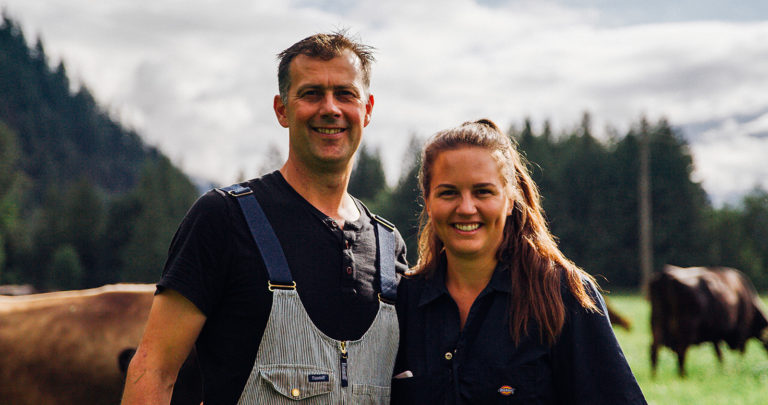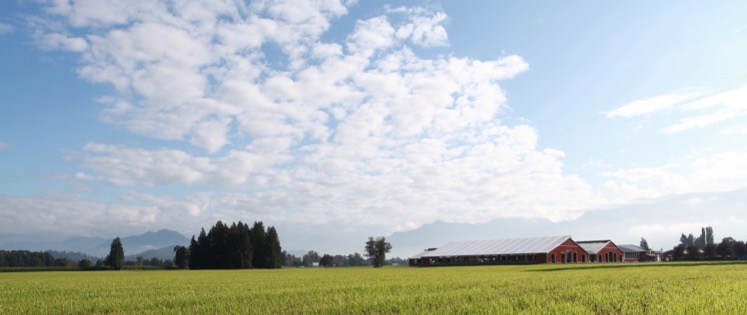Did you ever wonder what goes into getting that milk to you?
There is nothing better than a glass of ice cold cow’s milk. But did you ever wonder what goes into getting that milk to you? British Columbia has around 500 dairy farms producing milk for you to drink.
Most dairy producers milk their cows twice a day and some three times. Morning and night the average farmer is in the barn bringing his cows into the milking parlour where their milk will be collected and stored into a cooling bulk tank. Every second day, milk is picked up by a special tanker truck and shipped to a milk processing plant. From the processing plant, fresh milk, cream, cheese, yogurt, butter and other dairy products make their way to your nearest grocery store.
Milking
Cows are milked in specialized milk facilities called milk parlours. Every milking parlour is different – there are parallel parlours, side opening parlours and even rotating parlours. An average parlour can accommodate 12 cows at a time. Once in the parlour, the cow’s udders are disinfected and a milking machine is gently placed on each of the four teats. It takes about 5 – 8 minutes to milk each cow. Once milked the cow returns into the barn to drink, eat and rest in comfortable stalls bedded with dry sawdust. This cycle repeats itself every 12 hours.
Managing the Herd
In addition to the milking herd, producers have to manage the newborn calves, replacement heifers, dry cows, and sometimes breeding bulls. They have to be well organized in order to keep track of the many life processes that occur daily on their farm including birth of calves, raising of the calves, selection and breeding of the heifers etc. As well, each herd has a “Herd Health Program” designed by the farmer and his veterinarian. In addition to emergency calls, veterinarians visit the farm regularly to assist the farmer with maintaining the health of the dairy animals. Some producers use management software while others use recording calendars and other organizational tools that are available to them. More and more frequently, producers are employing the Canadian Quality Milk program as a way of developing effective operating procedures, not only for herd management, but for many other aspects of dairy farm management as well.
Life of a Cow
Dairy cattle have to grow up just like people do. A dairy cow must first give birth to her calf before she can produce milk. Newborn calves are fed her mother’s colostrums as soon as possible after it is born. This passes on special ingredients from the mother to the calf, which assist in ensuring the calf is healthy and has natural immunity to disease. As they get older, they get trained to drink out of a bucket and eat special cereal. When they are little they stay in their own separate pens to help prevent the spread of disease. As they grow up, they are kept in small groups so they learn to get along with each other…kind of like “cow pre-school”. Young female cows, roughly 6 months old, that have not given birth to a calf are called ‘heifers’.
Heifers are usually fed silage (cured grass), hay, and grain, or they are put out to graze. At 6 months of age, holstein heifers weigh about 180 kilos, and at about two years a cow will have her first calf. Cows usually have a calf every 12 to 14 months.
Dry cows are adult female cows that have had their calf and produced milk for 305 days. After 305 days of milking, the cow is about 7 months into her pregnancy and is given a two month rest before she gives birth. These cows do not produce milk during this two month rest period and hence the term ‘dry’. When the calf is born, the cow begins producing milk again and the cycle of life and milk production continues.
Most farms do not have bulls (males used to breed the cows) running around. Most farms use ‘artificial insemination to breed their cows. Cows are bred at 12 to 14 months of age and about one to two months after the birth of their calves. Artificial insemination allows the farmer to select the individual genetic characteristics that they want for their herd.
An adult dairy cow weighs over 700 kilos, is anywhere from 5-7 years old and has 4-5 calves in her lifetime. She can eat over 45 kilos of feed a day and can produce over 45 litres of milk a day during the early part of her lactation. A mature cow produces about 25 percent more milk than a first calf heifer.
Dairy Lifestyle
Most dairy farms are family run operations. After school, the kids help with the chores around the barn and the moms and dads take turns milking the cows. Everyone pitches in. Some larger dairy operations have hired help to assist with the milking and farming.
When the cows aren’t getting milked and the calves aren’t getting fed there are still lots of chores to be done. The milking parlour needs to be washed after every milking and all the milk lines are to be cleaned and sanitized. The barn needs to get cleaned out everyday because dairy farmers want their cows to be clean and disease free. Water troughs get cleaned and feed gets put out for the cows.
Most dairy farms grow their own feed for their cows so there is much field work to be done in the spring, summer and fall. In the spring, the fields get ploughed and crops planted. The crops are harvested when they are mature and the feed is brought to the farm and stored. This feed is combined with grains to make a special “ration” for the cows. This ration has all of the nutrients a cow needs to produce lots of high quality milk.
Next time you drink milk, think of all the hard work that was put into getting this wonderful product to you. Ask any farmer and they will tell you that they run a busy schedule but they wouldn’t trade the farm lifestyle for anything!



